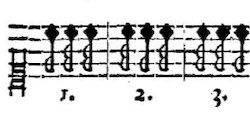In the second volume of his monumental Phrynis (Mytilenæus) Oder Satyrischer Componist (1677), Wolfgang Caspar Printz (1641–1717) gives the following definition:
“Figura Corta consists of three fast notes / of which one is as long as the other two combined.”
“Figura Corta besteht aus dreyen geschwinden Noten / deren doch ein so lang ist / als die übrigen beyde zugleich.”


Printz’s musical examples make clear that
- a figura corta, or simply corta, coincides with the length of one beat and therefore belongs to the decoratio, i.e. the figuration of a musical passage
- there are three types:
- a common type with the longer note first
- a rare, syncopated type with the longer note in the middle
- a common type with the longer note last.
Johann Gottfried Walther (1684–1748) reproduces Printz’s definition almost verbatim, although he doesn’t include the syncopated version:

p. 244, public domain, available on https://imslp.org

A variant of the figura corta, the figura suspirans, or simply suspirans, is discussed in a separate essay.
Select Bibliography
Butt, John. Bach Interpretation — Articulation Marks in Primary Sources of J. S. Bach (Cambridge: Cambridge University Press, 1990).
Printz, Wolfgang Caspar. Phrynis Mytilenæus Oder Ander Theil des Satyrischen Componistens — Ander Theil (Quedlinburg, 1677).
Walther, Johann Gottfried. Musicalisches Lexicon (Leipzig, 1732).
